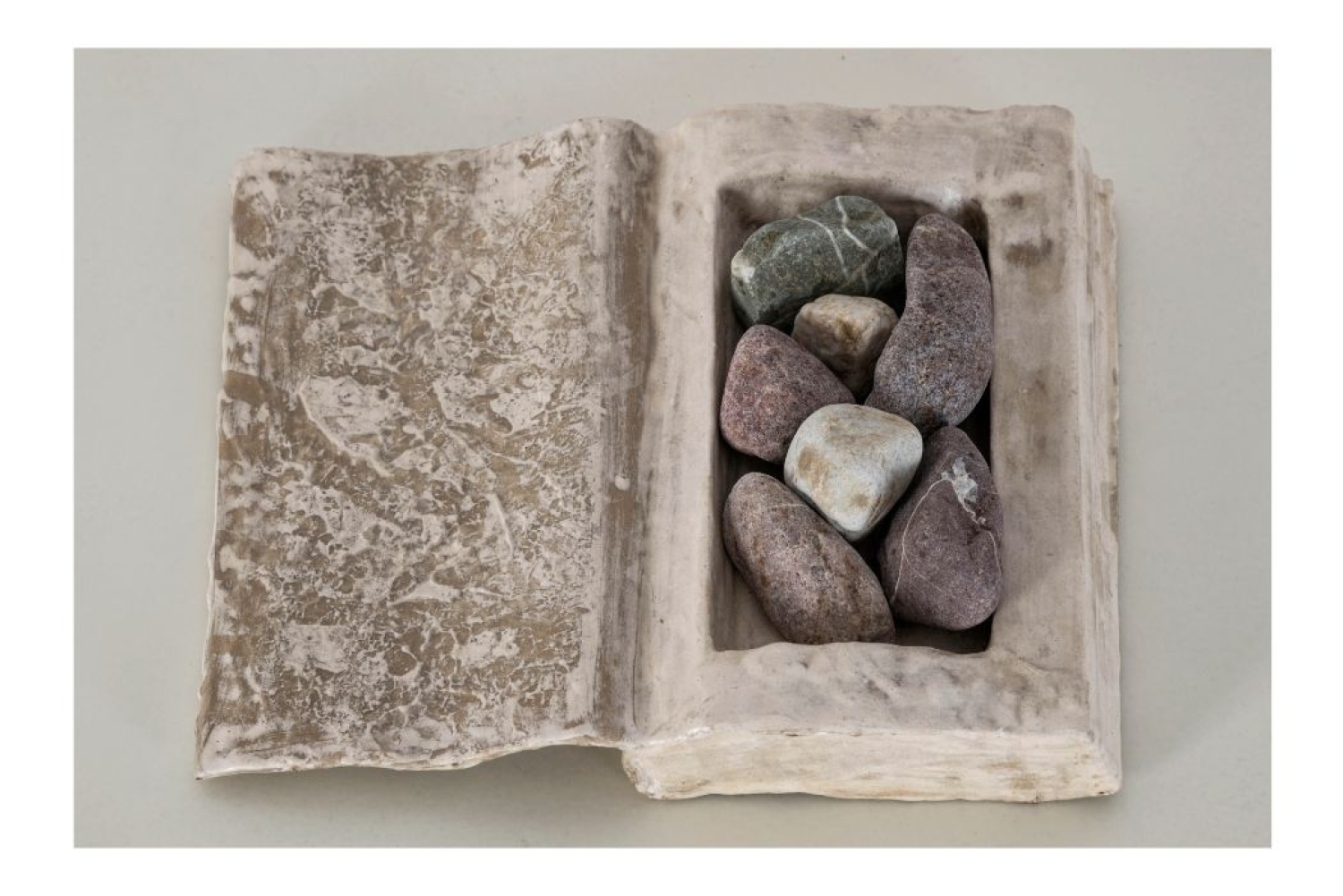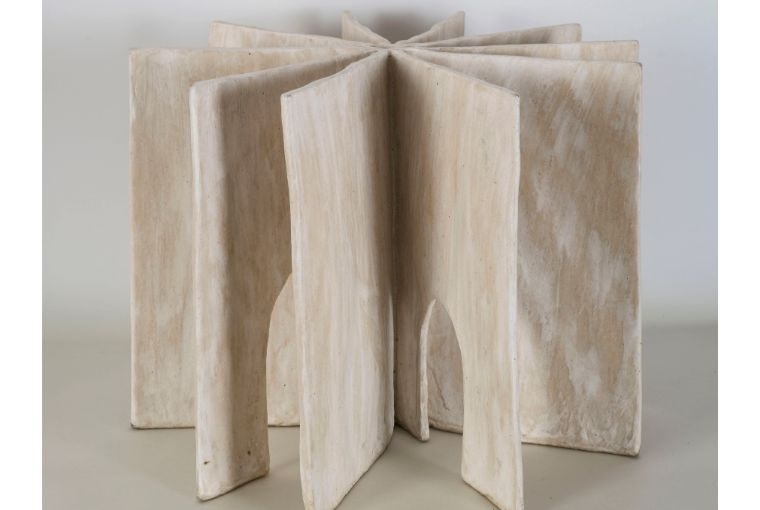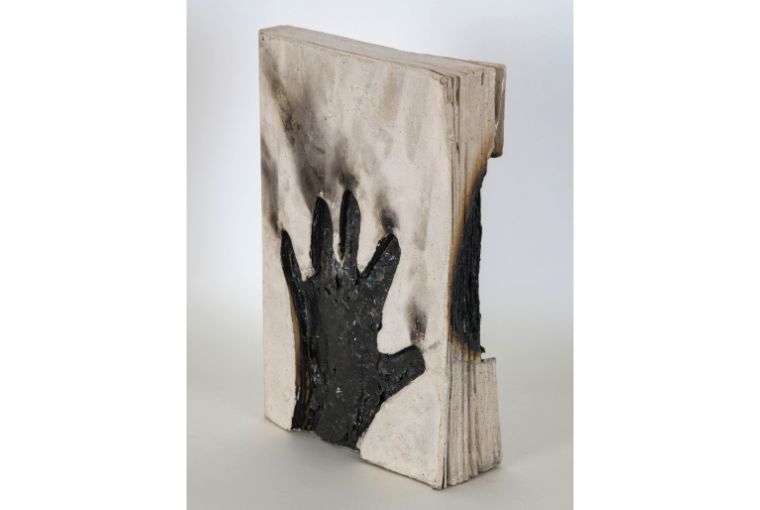
Embalmed Book 2, 2014. Clay, river stones, Collection: Saba Hasan studio

Embalmed Book 2, 2014. Clay, river stones, Collection: Saba Hasan studio
Several domains comprise the basis of Saba Hasan’s oeuvre: knowledge, memory, and the metaphysical. These domains have been defined and shaped over Saba’s interregional, multicultural early life. She has been trained as an anthropologist, and has an instinctive understanding of the interrelation of a culture’s language, belief, and perceptions. She stitches together video, sound, sculpture, photography, and the art of the book to examine the mechanisms of truth formation, inheritance, and imposition. Saba has spent over three decades working across different art media and building a philosophy, and has a profound understanding of the ecosystem of the intersectionality of art.
Books are the center point of this inquiry. For Saba, books are more than just containers of knowledge; they are pulled subjectively, distorted, and longed after. They are embedded with the complex histories of how human beings construct meaning. She turns books into sculptures, totems, and meditations. Often, she transforms them through burning, layering, wrapping, and reshaping into objects that embody fragility and resilience. Across various media, she constructs her own language from the amassed materials, natural textures, and a personal syntax of signs and movements.
As an artist who has exhibited internationally and received major recognitions including the Raza National Award for Painting in 2006, the Pollock Krasner Foundation Grant in 2022, and The Mannheim Arts Festival Best Art Film Award 2023, Saba continues to push quietly yet insistently against the limits of human knowledge. In the following conversation, Saba reflects on her relationship with books, the evolution of her personal alphabet, the power of transformation and the emotional truths she hopes viewers will carry with them.
What first drew you to books as material, and what possibilities did you see in them?
I have grown up in a cosmopolitan ethos, where the search for knowledge was highly respected, and where my literary and academic family gave me a very early introduction to reading books and discussing ideas. I studied a range of subjects like cultural anthropology, economics, art history, so books or formal propositions are not strangers to me. I chose books as material for art for this reason, they are everywhere in my house and I possess a sense of intimate familiarity with what they contain, whether it is reality or fiction.
It has always been of significant concern to me, that while all these books may signify truths, their specific content comes with coded meanings and a subjectivity. To me they also reveal the pitfalls that surround human knowledge, as they often contain distorted truths and ideals sometimes formulated and enforced on people by societies. After all, there are limits to what human beings know or can know, and our seemingly utopian visions often result paradoxically in oppressive codes of thought.
The ‘nine book installation’, where the Books when covered or wrapped with the words hidden acquire a larger meaning, converted to suggest something completely different from the ideas imbued in their content originally. This installation was born during the time I was reading on religion as the divine truth and debating the existence of an absolute versus multiple truths, while also looking into the politics and ethics behind prevailing ideas, and introducing possibilities of structuring truths. The ‘nine book installation’ also has a spiritual and philosophical dimension founded in Sufism, which draws from mysticism, and hence the later title Sulehkul.

The Book of Night, 2013. Gold leaf, ink, clay resin, Collection: Saba Hasan studio
What is the relationship between language and your sculptures?
If you deliberate over the work, then it’s really not language, but it’s knowledge or the book itself, which is at the core of my work. Language can be any, it could be Urdu, it could be the language of music, of the ocean, of time or maybe not at all. If anything, it’s the failure of human languages that I am convinced of, as you can see in my work Tower of Babel. I have always meticulously layered a variety of materials in my work, and initially there were a lot of textual elements, with mostly poetic references. I also used my mothers letters and transcripts of her translations of authors like Mahasweta Devi and some feminist Urdu writing extracted from Rashida Jahan and Ismat Chughtai. The book I have used in my work, Book in a Smashed Box is the feminist Urdu writer Ismat Chughtai’s book titled Ziddi, so there has been text as we know it in my work, in and outside of book sculptures, but now even that has disappeared.
Over the many years of my multimedia artistic practice, however, I have built my own alphabet, which may not be known or familiar as this new language contains signs for concepts as set by me. You can see this body of work through the lens of my identity where I use several media like video, voice, sculpture and paintings to speak a language of time, ephemeral, transient and permanent. I choose materials for the sculptures to suit this personal lexicon, it consists of clay and of gathered, largely organic elements from nature like sand, leaves strings or shells to build my meaning. As text has disappeared, my sculptures unveil a knowledge which I carefully shape in this created language, pointing towards the beauty of the natural world and its power over life, leading to a simple truth which is clearly universal.

Threshold Series, 2020- 2022. Clay on book, mixed media, Collection: Saba Hasan studio
Books are traditionally seen as vessels of knowledge. What does transforming them allow you to express?
Yes, that is the point, books are associated with knowledge and it is to challenge that perception of knowledge handed down to us as something sacred, that perhaps became the raison d’etre for these works. especially the ongoing Burnt Book series. Burning of books was originally in the category of questioning the validity of the text, its divinity, ideas and social prejudices we inherit. I burnt my first books in 2003 using the technique as an act of protest, when all this knowledge and so called 'profundities' make no sense any more in the light of brutality, prejudice, lies. Then, it occurred to me that it need not end at a destructive act, that it can become an act of transformation, a metamorphosis, as in my video where I burn a book lying on grass into ash and in the last smoky frame the ash just floats away crumbling into the wind. Perhaps, as it is set free.
With these book sculptures I try not only to change their outward appearance, but to influence their inner meaning and the character of 'all-knowing' that books bring with them to begin with. Transforming them allows me to to be irreverent, to blur the line between reality and poetry, and to express my feelings as totems, as spiritual symbols and intimate memories, the moulding of these sculptures is such that the books get reshaped by me into something primal and pure. We can look at the old in a new light and by using creative imagination, imbue them with new meanings completely. I put into them what we believe in, what we live by, what is precious in life, what we deeply fear or desire, doubt, nurture and protect. They come of my faith in humanity, they are life affirming. Even the burnt books are transformed bodily and spiritually, into giving hope, and glimpse into a kinder gentler, more beautiful world.

L: Burnt Manuscript, 2011. Box, manuscript, Collection: Saba Hasan studio. R: Book of Ocean (series), 2022-23. Shells, clay on book, Collection: Saba Hasan studio
Where do you look for inspiration? What is your perspective on the transformative potential of everyday objects, like books?
Inspiration has always come to me from within and from my environment, having left India with my journalist parents at the age of six, my multitudinous acculturation started early. I was in a school in Moscow studying Russian Literature, starting a PhD in Anthropology at Syracuse in New York, later gazing at Turner paintings during my Art History courses at Cambridge, Art Residencies in Paris, Salzburg - Austria, Sri Lanka. All this travel through cultures, languages, fashion, food, and incessant trips to museums around the world, I became of a world which is diverse and overflowing with cultural experience. My world view became as anthropologists say, wholistic and politically completely egalitarian.
Music has always been a big love, and watching live Kishori Amonkar in the park, or going to jazz clubs, a Mitsuko Uchida recital, the inspiration there is such that I learnt to play a few pieces on the piano myself. I got the opportunity to see saw Tarkovsky’s Solaris the year it was released in Moscow and I am an avid film buff, from Godard, Agnes Varda to Rituparno Ghosh and Aparna Sen, my sensibilities have been honed through years of profuse viewing. When I shot my first video in Paris, the inspiration came from the sound of the bells of Notre Dame which I heard regularly from my apartment in Isle Saint- Louis. I recorded that sound over a decade each time I went to Paris. I guess you can say my inspiration comes from an inner striving, a striving stemming from curiosity, an ability to abstract from my experience and a need to re-imagine, purify and reshape.

A Child’s Voice, 2024. Clay and ash on book, Collection: Saba Hasan studio
What do you hope for viewers to take away from your display?
Well, the viewer, after the artist is the other most important factor to interpret and give meaning to art like mine, which is not literal or even figurative. Forms of most book sculptures are unusual, and may appear abstract, but I have crafted them with a lot of thought and care. Since no single narrative can explain the layered complexity of such a substantial multi-media body of work, it might take a little time, but art is after all to be experienced.
A fashion designer wrote that when she saw this solo exhibition, she felt like she was standing ‘inside a quiet storm, one where language dissolves and emotion takes its place’. As a sensitive viewer, she clearly saw the duality in my work of chaotic tension and calm restraint, as well related to its emotional depth. Anyway, I am not looking to be understood. An emotional response, a connection - that honest simple moment matters more. There are many different media at this show, videos, poetry, paintings, sculptures, yet I trust the viewer to find their way, to connect with it emotionally. If you free yourself there are no boundaries of entry into my world.
What’s next, what’s the future looking like?
The future is looking good, it is going to be in a village by the sea, behind the big white church in the shade smelling of marigolds, where I will paint surrounded by swaying coconut trees, a family of blue eared kingfishers and tall hibiscus bushes. I will paint in thin slow washes of colour which I will apply with a long sweep of my arms mimicking the ocean waves till the painting slowly floods with luminous colour, to mark the beauty of life, our natural elements and the mystery of what lies ahead. I will occasionally walk on the beach where fishermen sell their daily catch from wooden boats, pay them more than they ask for, and put the sea food in my straw basket with quiet contentment, like a Cheshire. At dusk, my favourite part of the day, I will sit down and gaze at the horizon where the sky kisses the shimmering sea, smiling as I wait for my granddaughter Iman to video call me from New York and ask me about butterflies that live in my garden.
Saba's multi-media exhibit of book sculptures, will be on view at KNMA, Delhi until 10th January, 2026.
Date 27-11-2025